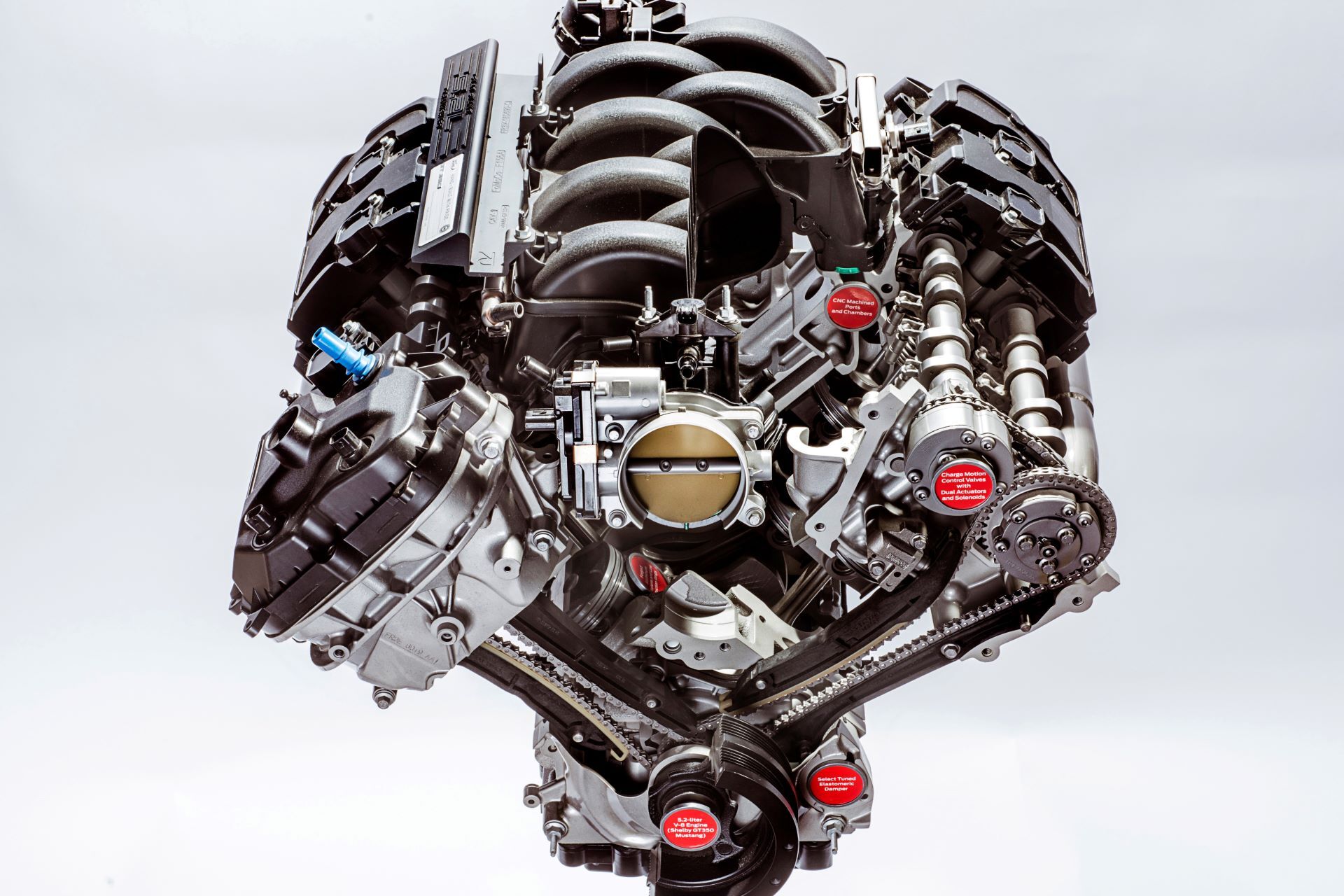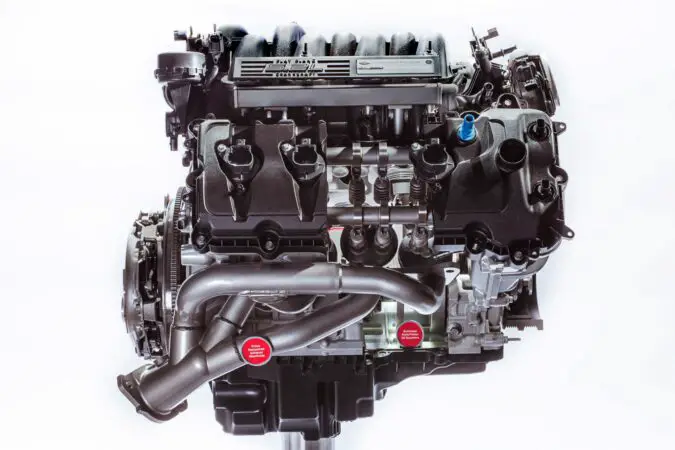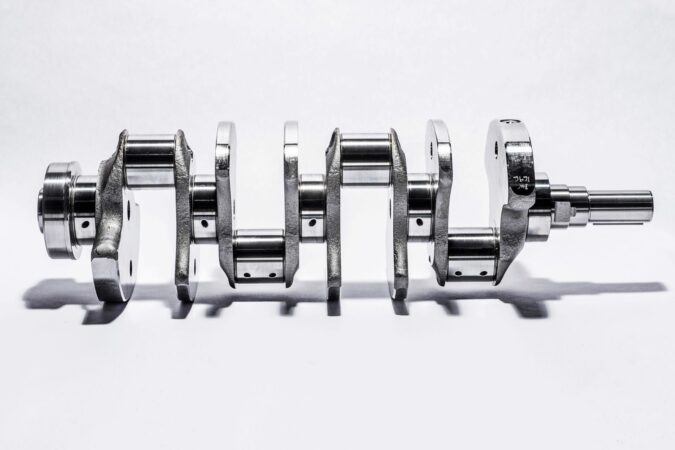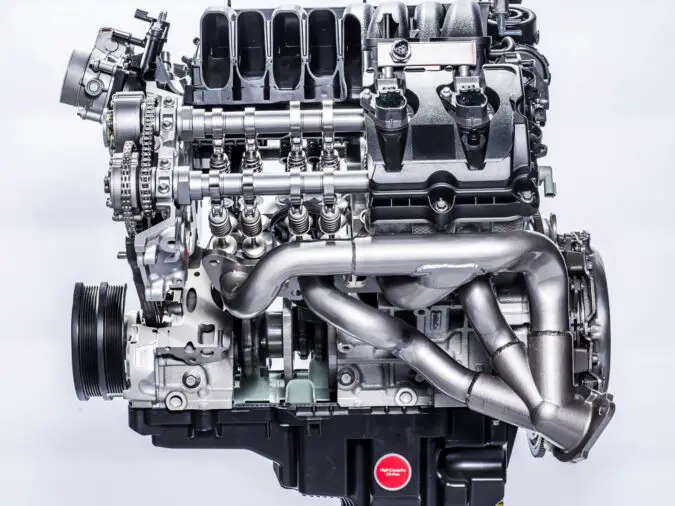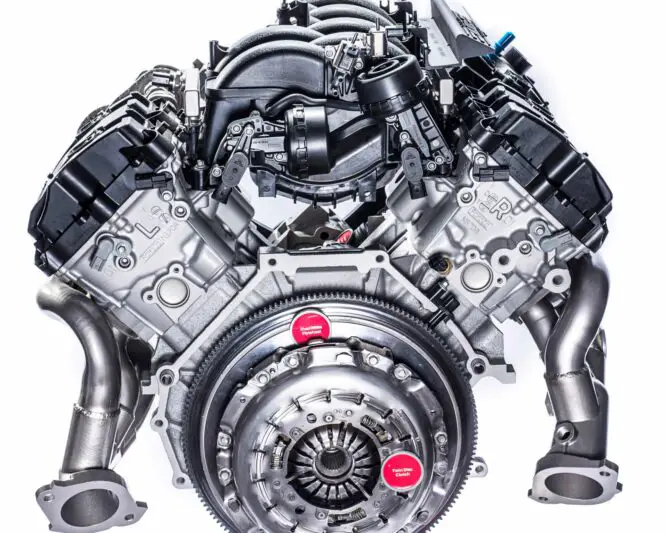The Ford’s 5.2 Voodoo engine, a high-rpm monster only found in the Shelby GT350 and GT350R Mustangs, is a beast of its own. Let’s just say that if you enjoy the sound of a roaring V8 engine vs a commonplace V6, this one will surely impress.
We go over the specifics of this 5.2-liter V8 engine, including how it differs from earlier engines produced by the manufacturer.
With the 2016 Mustang, Ford brought the legendary Shelby GT350 name back. A remarkable 5.2-liter V8 engine with the Ford codename “Voodoo” is located under the hood.
The 4.6-liter V8, which made its debut in the 1991 Lincoln Towncar, is the ancestor of the modular engine family (the predecessor of what we’ve discussed in our write-ups on the problems with the Ford 5.4 engine, as well as the 2010 Ford F150 and its 5.4 powertrain), which includes the 5.2 Voodoo V8 engine.
However, the Ford Modular engine family has undergone some amazing developments as a result of years of technological advancement, and Mustangs by year over year have gotten more potent. Without a doubt, Voodoo is no exception.
Voodoo Engine
Modern technologies like dual overhead camshaft (DOHC) construction, far superior when looking at SOHC vs DOHC, and variable valve timing are features of the 5.2-liter Voodoo V8 engine.
However, the Voodoo engine has a feature that is exclusive to it and has never been on any other Ford engine throughout the company’s history. It has a distinctive sound because of the flat-plane crankshaft it uses.
Many will always remember Ford’s distinctive Voodoo engine as a remarkable technological achievement, even though the automaker announced that the GT350 and GT350R would be discontinued after the 2020 Mustang model year.
The GT350 and GT350R also provide a fantastic opportunity for a good time without breaking the bank in terms of sports car pricing if you’re looking for a fun weekend sports car, perhaps you can drive to the race track or even canyons.
Let’s analyze the 5.2-liter Ford Voodoo V8 engine specifications in detail.
We’ll begin by addressing the most frequently posed query about the 5.2 Voodoo engine: What distinguishes a cross-plane crankshaft from a flat-plane crankshaft?
5.2 Voodoo Engine – Modern Tech & Panoramic Crank
As previously mentioned, the flat-plane crankshaft of the Voodoo engine in the GT350 makes it particularly distinctive.
Without getting too technical, a cross-plane crankshaft (like you’ll find in most Ford V8s) has connecting rods attached every 90 degrees, whereas a flat-plane crankshaft has them every 180 degrees.
Therefore, in comparison to a typical V8 crankshaft, a flat-plane crankshaft V8 functions more like a four-cylinder crankshaft.
This implies that the engine’s pistons will always alternate between the sides as they rise and fall.
All of this basically means that the crankshaft allows for higher and faster engine revs while requiring fewer counterweights.
High-end sports cars like Ferraris use crankshafts like this one. Additionally, it is this that produces the distinctive Ferrari-like higher-pitched engine sound.
The Ford Voodoo V8 successfully combines American V8 grunt with flat-plane wailing. Additionally, it offers uniformly spaced exhaust pulses, doing away with the need for intricate exhaust channels leading to the exhaust manifolds.
The development of secondary balancing problems is the main drawback of using a flat-plane crankshaft. This indicates that the crankshaft is slightly out of balance at some points during its rotation.
This may result in a noticeable shaking or vibration that may discourage people from wanting to drive a car on a regular basis.
But given the characteristics of the Shelby Mustang GT350 and GT350R, it’s unlikely to turn off any prospective buyers.
It is generally the case that you must give up some creature comforts when buying a high-performance vehicle.
5.2 Voodoo Engine
Given that the Voodoo V8 takes inspiration from the Ford Modular engine platform, you will see a standard 90-degree V-shape layout.
The 5.2-liter V8 Ford Voodoo engine is built with dual overhead camshafts as standard. This indicates that there are a total of four camshafts in the engine, two in each of the cylinder heads.
It also has variable valve timing technology to improve the air-to-fuel ratio based on engine rpm, ensuring that you get the best air-to-fuel ratio possible.
Aluminum makes the engine block and cylinder heads. Its 93-millimeter stroke and 94-millimeter bore dimensions.
Additionally, it has a 12-to-1 compression ratio, which is astoundingly high.
For an eight-cylinder engine made in America, the Voodoo V8’s redline is incredibly high at an astounding 8,250 rpm.
These characteristics work together to produce 526 horsepower and 429 lb.-ft of torque. Additionally, the 5.2 Voodoo engine is only available in the Mustang GT350 and GT350R, and it only comes with a six-speed manual transmission.
5.2 Voodoo Engine Problems
The timing chain assembly is the Ford Voodoo engine’s most obvious problem. Although the timing chain or any of its parts could fail and wreck the entire engine, this problem is currently under review. This would no doubt impact significantly when you’re wondering how many miles do Mustangs last.
The Mustang Source claims that Ford published a technical service bulletin outlining how to check for this problem as well as how to fix it.
Timing chain tensioners that were installed incorrectly are the cause of the issue. Even though losing chain tension does not always or right away result in engine damage, Ford recalled each and every affected vehicle and notified owners.
Additionally, they halted sales of the affected vehicles in dealer inventories until the issue was fixed.
The Voodoo’s propensity for consuming oil is another thing to be on the lookout for. During their 40,000-mile journey while driving a GT350 for a year, Car and Driver had to add 21.5 extra quarts of oil on top of routine oil changes due to the car burning so much motor oil.
Additionally, they mention that some GT350 owners are reporting much worse oil consumption, which in some cases even results in engine failure.
But regrettably, there isn’t a recall or repair bulletin for this problem yet. Ford did, however, add to the owner’s manual that, under heavy use, the engine could use a quart of oil every 500 miles.
5.2 Voodoo Engine – Ford GT350
When the Blue Oval introduced the GT350R 6th-gen Mustang in 2016, the American muscle car community fell in love at first sight.
For the Shelby GT350 and later the GT350R, the Voodoo engine was naturally ready the previous year.
It’s nearly impossible to not be enchanted by the car; if the 5.2-liter flat-plane crank V8 doesn’t do it for you, the bold, aggressive styling and blood-red color most certainly will.
Because a 6-speed manual transmission is an option, the Mustang has an available 526 horsepower that is sent to the rear wheels during hard acceleration.
Official awards are frequently bestowed upon vehicles, but the Mustangs’ reputation on the streets and on the tracks is what has given them their legendary status.
Ford decided against altering the recognizable wide wheel arches and intimidating front grille in favor of concentrating on improving interior technology like the FordPass Connect.
It makes sense that the track-focused GT350R wouldn’t have a back seat. However, even the street-oriented Mustang Shelby GT350 is no timid pony.
Some people have the guts to push the Shelby past its tame 4000 rpm redline to its 8250 rpm Voodoo V8 redline. If you are one of these you will be rewarded with an ear-splitting soundtrack that is only heard in the Shelby.
5.2 Voodoo Engine – How Fast Is It
The GT350R could reach 60 mph in 3.8 seconds and reach 120 mph in the quarter-mile in 12 seconds thanks to the Voodoo.
The final Shelby GT350R cost about $5,000 more than the previous model, with an MSRP of $74,630.
Sadly, it appears that the 5.2 Voodoo engine lifespan will also come to an end with the end of production for the Mustang GT350 and GT350R.
Jim Owens, Ford’s head of Mustang Marketing, said in an interview with Ford Authority that they are not free to discuss upcoming products. They will also not discuss applications for the engine.
Ford does not currently offer a crate engine option for the Voodoo V8.
Therefore, buying a GT350 or GT350R Mustang remains the only way to actually own this powerful engine.
The current fair market range for a GT350 according to Kelley Blue Book starts at $39,692 for a 2016 model and goes all the way up to $68,888 for a 2020 model. The price of the GT350R is comparable.
However, older models should be avoided as their bumper-to-bumper warranty of three years and 36,000 miles has long since expired.
Additionally, the five-year/60,000-mile powertrain warranty for 2016 model-year vehicles is about to expire, which may necessitate expensive repairs if you experience engine problems.
GT350 vs GT350R
1. Price
Although the cost of these two Ford Mustang Shelby GT350s may seem excessive, the value you receive is excellent. The GT350 and GT350R both start at around $50,000 starting in 2015.
As of right now, in 2019, the prices increased quite a bit, partly due to the car market adjustment. The MSRP of the GT350 starts at roughly $59,140 and the 350R at roughly $70k.
Remember that these are just the starting prices.
2. 5.2 Voodoo Engine Performance
Despite everyone’s wishes, there isn’t a different engine for the two models. Both have the same insane 5.2-liter V-8 engine with a flat-plane crank. It produces 526 horsepower and 429 lb-ft of torque.
The 5.2L Voodoo engine enjoys squeezing air into its big throttle body and revving continuously. Dyno results show that the horsepower and torque curves are almost identical!
The GT350R’s performance on the track is what really sets it apart from the base model. Heavy-duty springs create a suspension that feels stiffer and coolers for the engine oil. They also affect the differential, and transmission fluid is two important upgrades to the “R.”
When comparing the 0-60 and quarter-mile times of these two Shelby Mustangs, the “R” model comes out on top (3.9 vs. 4.1 and 12.1 @ 119.6 mph vs. 12.4 @ 117.8).
Although these times are not Shelby GT500 territory, they are still very respectable for a track-oriented, high-revving v8! And hey, the top speed of the GT350 is higher than that of the top speed of the Mustang GT.
The horsepower ratings of both Ford Shelby GT350s are identical. Therefore these performance variations may be due to the GT350R’s carbon fiber wheels and the stickier Michelin Pilot Sport Cup 2 tires.
3. How About On The Standard GT350
In comparison to the wheels on a standard GT350, experts agree that you save nearly 60 pounds. Driving these cars back-to-back will undoubtedly feel like there is a lot of rotating mass present.
This is not the typical Mustang GT of yesteryear. It has solid axles better suited for straight-line performance at the drag strip.
This fast car was created by Ford with lap times in mind! The Ford Mustang Shelby GT350R and the standard GT350 only come with the Tremec TR-3160 manual transmission, in contrast to the 2020 GT500, which also has a 7-speed dual-clutch transmission.
Ford and Shelby American collaborated to construct the first GT350s in the middle of the 1960s. During this time, Ford maintained the vintage racer mentality of Carroll Shelby.
MotorTrend claimed that the exhaust note of the GT350 and GT350R was noticeably different. Due to this, they brought these two track monsters to a dyno to see if the “R” variant was producing more horsepower. The outcome?
- 467 hp at 7200 rpm for the GT350 (at the wheels)
- 471 hp at 7200 rpm for the GT350R (at the wheels)
The rotating mass difference with the wheels is most likely the cause of this difference. These engines, produce 526 hp and 429 lb/ft of torque. They are the same as we saw above.
After comparing the two on the dyno, 4 horsepower is not significantly different. However, the weight appears to be greater on the track than it is on paper.
4. Exterior
There were two different GT350 wheels, one for the GT350 and one for the GT350R. This is one of the biggest distinctions between the two.
The GT350’s standard aluminum wheels are replaced with carbon fiber wheels on the “R” model.
As was already mentioned, the conversion to carbon fiber allows this already-light muscle car to shed an additional 60 pounds.
Additionally, lighter wheels require less energy to move. This translates to faster reaction times, which can make or break a race.
The 16′-18′ “R”s also came with Michelin Pilot Sport Cup 2 tires, which weren’t made available for both models until 2019.
Due to their specialization in road racing and tight turns, these were absolutely necessary. Additionally, even in the rain, the 20% deeper tread keeps you moving quickly.
The carbon fiber grille opening is yet another significant upgrade. Both versions have this grille opening. That said, a smaller opening came in 2019 to help cool air as it enters the car.
Finally, the larger splitter and carbon fiber wing make this car much better. This wing is entirely exclusive to the “R” and is fully operational.
Both the splitter and the wing were designed to increase downforce in addition to lowering lift.
To achieve the performance look everyone wants, carbon fiber also helps reduce weight even further.
The “R “‘s” red exterior emblems serve as the finishing touch, further differentiating it from rivals.
5. Interior
The interior tops the list of things about the package that was disappointing. There isn’t much of a difference between the two interiors other than the “R” has a red stitch interior because both of these vehicles came with performance in mind.
Most notably, the GT350R lacks air conditioning and rear seats. When purchasing this vehicle for the first time, you can upgrade the “R” as an optional package; otherwise, the two models are identical.
6. Is The GT350R Pricey Enough
It ultimately comes down to personal preference.
Ford consistently produces performance Mustangs that are more affordable than those of its rivals, keeping them one step ahead of the competition.
FAQs About The 5.2 Voodoo Engine
What Is A Flat Plane Crank
For use in internal combustion engines, the flat-plane crankshaft has a 180-degree angle between crank throws.
How Much Horsepower Does A GT350 Have
The Ford Mustang Shelby GT350 has a 526-horsepower V-8 engine that helps it move quickly in a straight line even though it was built for corners.
What Liter Is A 350
The Chevy 350’s 350 cubic inches (5.7 liters) small block V8 engine has a bore and stroke measurement of 4.00 and 3.48 inches, respectively.

